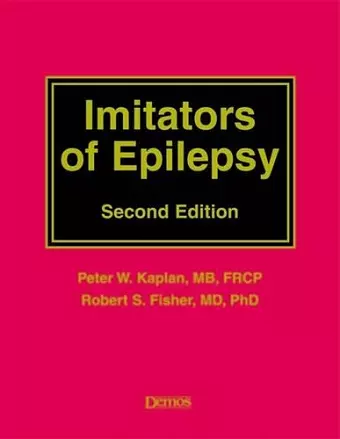Imitators of Epilepsy
Robert Fisher author Peter Kaplan author
Format:Hardback
Publisher:Demos Medical Publishing
Published:1st Dec '04
Should be back in stock very soon

Many patients referred for an Epilepsy evaluation actually suffer from one of many conditions that can imitate it. Imitators of Epilepsy are a diverse group that involve consideration of many areas of internal medicine, neurology and psychiatry. The most important imitators of epileptic seizures are dizziness, Vertigo, Syncope, Complicated Migraine; and somewhat less frequently sleep disorders, Transient Cerebral Ischemia, Paroxysmal Movement Disorders, Endocrine or Metabolic Dysfunction, Delirium, psychiatric conditions or Transient Global Amnesia. Clearly under-recognised are hyperventilation episodes, panic attacks, and other psychogenic and psychiatric paroxysmal disorders that may simulate epileptic seizures. This volume provides a comprehensive review of the differential diagnosis of seizures: how do the imitators of Epilepsy present clinically, what are their particular distinguishing historical features and what tests are helpful with diagnosis?
Expanding beyond the first edition, this second edition is divided into four sections. The first deals with an introduction and approach diagnosing spells, the electroencephalography of Epilepsy and its imitators and specialised tests of diagnosis such as measurement of serum prolactin. There are chapters on epileptic seizures that do not look like typical epileptic seizures, and conversely, apparent epileptic seizures that are not. A second section approaches imitators of epileptic seizures along age-based lines; i.e. what sorts of spells are likely to beset infants, children, or the elderly? A third section addresses individual imitators of Epilepsy, ranging from the common to the rare, from dizziness and faintness to startle disease, arranged according to whether they might simulate partial, generalised, or both types of epileptic seizures. The volume finishes off with Hyperventilation Syndrome, Psychogenic Seizures (with or without Epilepsy) and panic disorders.
Most chapters review the basic definitions and physiology of the respective imitator, followed by the clinical characteristics. Emphasis is given to those features that may differentiate it from an epileptic event, but also mark it for what it is, and give possible criteria for an alternate diagnosis. Case vignettes are used to illustrate particular aspects, along with tables that compare and contrast phenotypically similar conditions. Based on their extensive clinical experience, the authors provide a personal perspective on diagnosis and treatment.
""[This] book gives excellent insight into the 'border land' of epilepsy, a vast, but hitherto poorly charted territory. Imitators of Epilepsy will serve to increase the awareness of physicians for factors that distinguish epileptic seizures from their imitators, and to provide guidance to support clinical judgment in approaching patients with possible or unclear seizure disorders and related conditions... All chapters are well written, with informative subheadings and extensive reference lists.""-- European Journal of Neurology
From reviews of the first edition...
""... an excellent overview of the types of questions that run through the mind of a diagnostician"" -- New England Journal of Medicine
""...an excellent teaching tool to help with the differential diagnosis of seizure disorders... a handy reference for complex cases. "" -- Epilepsia
ISBN: 9781888799835
Dimensions: unknown
Weight: 1098g
296 pages
2nd Revised edition